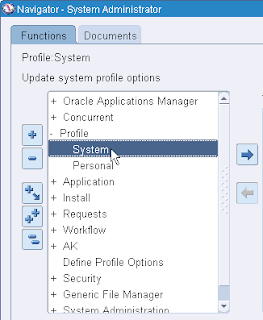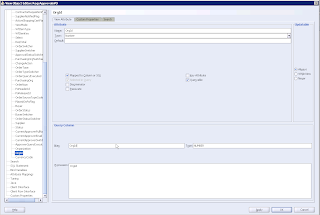SET SERVEROUTPUT ON
spool /tmp/XXCDS_HRXXXXX_ADD_RG.TXT
WHENEVER SQLERROR EXIT FAILURE ROLLBACK
BEGIN
fnd_set.add_set_to_group (request_set => 'FNDRSSUB1817', -- Request Set Code
set_application => 'XXCDS', -- Application Code Short Name
request_group => 'XXCDS Audit Request Group', -- Request Group Name
group_application => 'XXCDS'); -- Application Code Short Name
dbms_output.put_line('Request Set has been attached to Request Group Successfully ');
COMMIT;
EXCEPTION
WHEN DUP_VAL_ON_INDEX
THEN
dbms_output.put_line ('Request Set is already available in the Request group');
WHEN OTHERS
THEN
dbms_output.put_line ('Others Exception adding Request Set. ERROR:' || SQLERRM);
END;
/
SHOW ERROR
SPOOL OFF
Friday, July 31, 2015
Wednesday, June 18, 2014
How to Remove/End Date a Responsibility assigned to the User in Oracle Apps
DECLARE
v_user_name VARCHAR2 (100) := 'TEST_USER';
v_responsibility_name VARCHAR2 (100) := 'System Administrator';
v_application_name VARCHAR2 (100) := NULL;
v_responsibility_key VARCHAR2 (100) := NULL;
v_security_group VARCHAR2 (100) := NULL;
BEGIN
SELECT fa.application_short_name,
fr.responsibility_key,
frg.security_group_key,
frt.description
INTO v_application_name,
v_responsibility_key,
v_security_group,
v_description
FROM fnd_responsibility fr,
fnd_application fa,
fnd_security_groups frg,
fnd_responsibility_tl frt
WHERE fr.application_id = fa.application_id
AND fr.data_group_id = frg.security_group_id
AND fr.responsibility_id = frt.responsibility_id
AND frt.LANGUAGE = USERENV ('LANG')
AND frt.responsibility_name = v_responsibility_name;
fnd_user_pkg.delresp (username => v_user_name,
resp_app => v_application_name,
resp_key => v_responsibility_key,
security_group => v_security_group);
COMMIT;
dbms_output.put_line ( 'Responsiblity ' || v_responsibility_name || ' is removed from the user ' || v_user_name || ' Successfully' );
EXCEPTION
WHEN OTHERS THEN
dbms_output.put_line ( 'Error encountered while deleting responsibilty from the user and the error is ' || SQLERRM );
END;
Source: Thanks for Sharing
Monday, February 17, 2014
Error "Each row in the Query Result Columns must be mapped to a unique Query Attribute in Mapped Entity columns" while extending a VO
I was trying to extend the seeded iProcurement VO “ReqsApprovalsVO” with out adding any custom attributes.
I went back to the seeded VO to see if any of the attributes are having this issue. Right Click on “ReqsApprovalsVO” à Edit ReqsApprovalsVO
When I clicked “Next” button on the Step 4/7 (Attribute Mappings), I hit this roadblock which keeps saying “Each row in the Query Result Columns must be mapped to a unique Query Attribute in Mapped Entity columns” and does not let me extend the VO after this.
I thought of several reasons which could be causing this error. I thought it had something do with the file version of the seeded VO I am trying to extend or it could be due to the jDeveloper version I am using.
I ruled out all the possibilities one by one including the jDeveloper issues. Then I looked in metalink and one of the notes gave me a little clue which would solve my issue.
Source: Metalink Note: 1524622.1
I went back to the seeded VO to see if any of the attributes are having this issue. Right Click on “ReqsApprovalsVO” à Edit ReqsApprovalsVO
I found this attribute OrgId which is “Mapped to Column or SQL” and has the Query column as “OrgId”
When I verified the SQL Statement for this VO, OrgId attribute has been pulled as “Org_Id” in the query which is not same as “OrgId” and this explains me why the error has been occurring when I am trying to extend the VO.
To resolve the issue, I changed the OrgId to ORG_ID in the seeded VO and was able to extend the VO there after.
Tuesday, February 11, 2014
Upload or Download Oracle Workflows using WFLOAD Command Line Utility
Oracle Workflows are Database Applications whose definitions are stored in different Database Tables.
We can easily Upload/Download these definitions of the Workflows to the flat files using WFLOAD command line utility.
Workflow files are stored under <Application Top>/patch/115/import/US/ (Ex: PO_TOP/patch/115/import/US/powfpoag.wft)
To Upload
--------------
WFLOAD apps/<apps_password> <Access_Level> Y <upload_mode> <file_name>.wft
Example: WFLOAD apps/appspwd 0 Y FORCE powfpoag.wft
To Download
--------------------
WFLOAD apps/<apps_password> <Access_Level> Y DOWNLOAD <file_name>.wft
Example: WFLOAD apps/appspwd 0 Y DOWNLOAD powfpoag.wft
Different Access Levels Used:
0 - 9
|
Reserved for Oracle Workflow
|
10 - 19
|
Reserved for Oracle Application Library
|
20 - 99
|
Reserved for Oracle E-Business Suite
|
100 - 999
|
Reserved for Customer Organizations
|
1000
|
Public
|
Different UPLOAD modes used while uploading the WFT file to the database.
UPGRADE
|
Honors both Customization and Protection Levels of Data.
|
UPLOAD
|
Honors only Protection. Customization Levels are not respected.
|
FORCE
|
Both Customization and Protection Levels are not honored.
|
Usually all the Oracle Patches run the Workflows in UPGRADE mode and access level of 20 and hence our customizations are protected if properly preserved.
Thursday, February 6, 2014
Basics about Profile Options
Profile Options are like Global Variables for Oracle Applications. They provide flexibility to Applications and how they work.

From the System Profile screen, you are making changes to the profile options at any level including personal/user
There are 2 types of Profile Options
1 1. System Profile Options
2. User Profile Options
When logged in as System Administrator, the difference between System Profile and Personal Profile are to whom you are making the changes for.
To Navigate to System Profiles
System Administrator à Profile à System
System Administrator à Profile à System

From the System Profile screen, you are making changes to the profile options at any level including personal/user
From the User Profile Screen, you are making changes to the profile option values for yourself /user(who logged in). To navigate to Personal Profile:
System Administrator --> Profile --> Personal
System Administrator --> Profile --> Personal
Oracle Data Security and its components
Data
Security: Coordinating with Function Security, Data Security provides
additional security on the data. It lets the administrators decide what are all
the actions that users can perform on the data.
Data
Security Policies can reflect access to
a. All Instances : All instances of an object represents that all rows in the database related to that object. If you consider Purchase Order (PO) as an object and All Instances of PO means all the Purchase Orders in the database.
b. Instance Set: Instance set of an object represents a set of the related instances of an object. In our Purchase Order as an object example, a set of Blanket Purchase Orders represent a set of Instances of the PO.
c. A Specific Instance: This generally represents a single row in the database. It is usually identified by a Primary Key value for the object(Ex: PO Header Id)
a. All Instances : All instances of an object represents that all rows in the database related to that object. If you consider Purchase Order (PO) as an object and All Instances of PO means all the Purchase Orders in the database.
b. Instance Set: Instance set of an object represents a set of the related instances of an object. In our Purchase Order as an object example, a set of Blanket Purchase Orders represent a set of Instances of the PO.
c. A Specific Instance: This generally represents a single row in the database. It is usually identified by a Primary Key value for the object(Ex: PO Header Id)
Wednesday, February 5, 2014
How to see Account Generator Workflows in Status Monitor of Workflow Administrator
By default, Oracle Account Generator Workflows does not show up in the Workflow Status Monitor screen of Workflow Administrator. To be able to see them in the status monitor, couple of profile options should be enabled to “Yes”.
Wednesday, October 9, 2013
How to get a Total Amount on a Standard Purchase Order
Oracle provides couple of API's to
get the Total Amount on a Standard Purchase Order. Using this API, you don't
have to worry about the calculation of the Quantity x Unit Price and what needs
to be excluded from the calculation.
To get the Total Amount of the current revision of the Standard Purchase Order
##########################################################
DECLARE
l_total NUMBER := 0;
BEGIN
l_total := po_core_s.get_total('H', :p_po_header_id);
dbms_output.put_line('PO Total Amount:'||l_total);
END;
##########################################################
To get the Total Amount of any previous revisions of the Standard Purchase Order, use the following API.
##########################################################
DECLARE
l_total NUMBER := 0;
BEGIN
l_total := po_core_s.get_archive_total_for_any_rev
(:p_po_header_id,-- PO Header Id
'H', -- Standard Header
'PO', -- Document Type
'STANDARD', -- Document Sub Type
0, -- Revision Num
'Y'); -- Base Currency
dbms_output.put_line('PO Total Amount:'||l_total);
END;
###########################################################
To get the Total Amount of the current revision of the Standard Purchase Order
##########################################################
DECLARE
l_total NUMBER := 0;
BEGIN
l_total := po_core_s.get_total('H', :p_po_header_id);
dbms_output.put_line('PO Total Amount:'||l_total);
END;
##########################################################
To get the Total Amount of any previous revisions of the Standard Purchase Order, use the following API.
##########################################################
DECLARE
l_total NUMBER := 0;
BEGIN
l_total := po_core_s.get_archive_total_for_any_rev
(:p_po_header_id,-- PO Header Id
'H', -- Standard Header
'PO', -- Document Type
'STANDARD', -- Document Sub Type
0, -- Revision Num
'Y'); -- Base Currency
dbms_output.put_line('PO Total Amount:'||l_total);
END;
###########################################################
Thursday, September 12, 2013
FND_REQUEST.ADD_LAYOUT for Setting Layout options for a Concurrent Request
Using FND_REQUEST.SUBMIT_REQUEST, Concurrent Request can only be
submitted as a request and any layout options or print options cannot be added
to the request. To be able to set the layout options for a request a separate function
FND_REQUEST.ADD_LAYOUT needs to be called before calling the SUBMIT_REQUEST.
This will be useful while calling a XML Publisher Report Concurrent Program is
being submitted from another Program.
fnd_request.add_layout (template_appl_name =>
'Template Application',
template_code => 'Template Code',
template_language => 'en', --Use language from template definition
template_territory => 'US', --Use territory from template definition
output_format => 'PDF' --Use output format from template definition
);
template_code => 'Template Code',
template_language => 'en', --Use language from template definition
template_territory => 'US', --Use territory from template definition
output_format => 'PDF' --Use output format from template definition
);
Subscribe to:
Comments (Atom)










